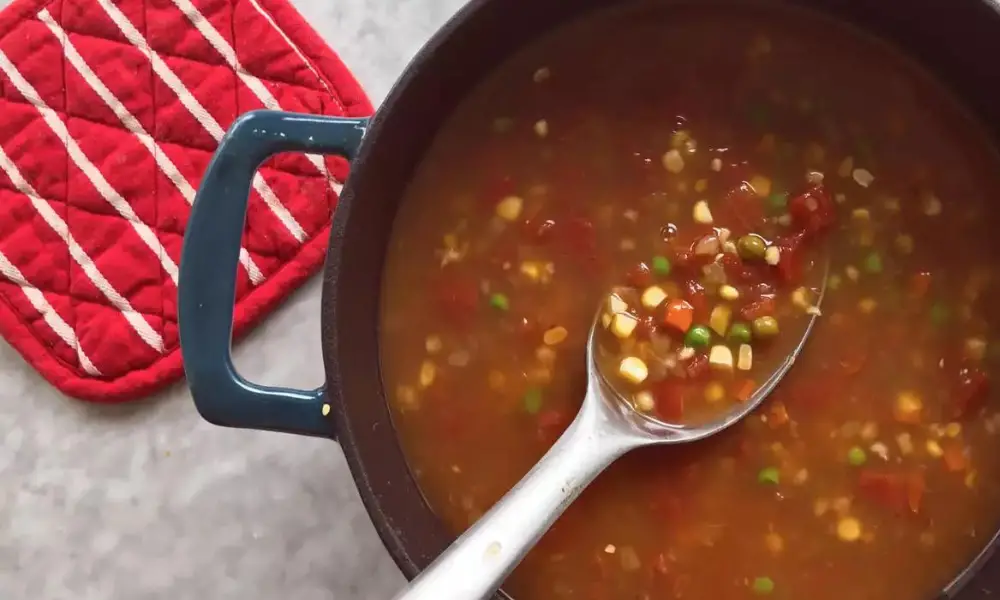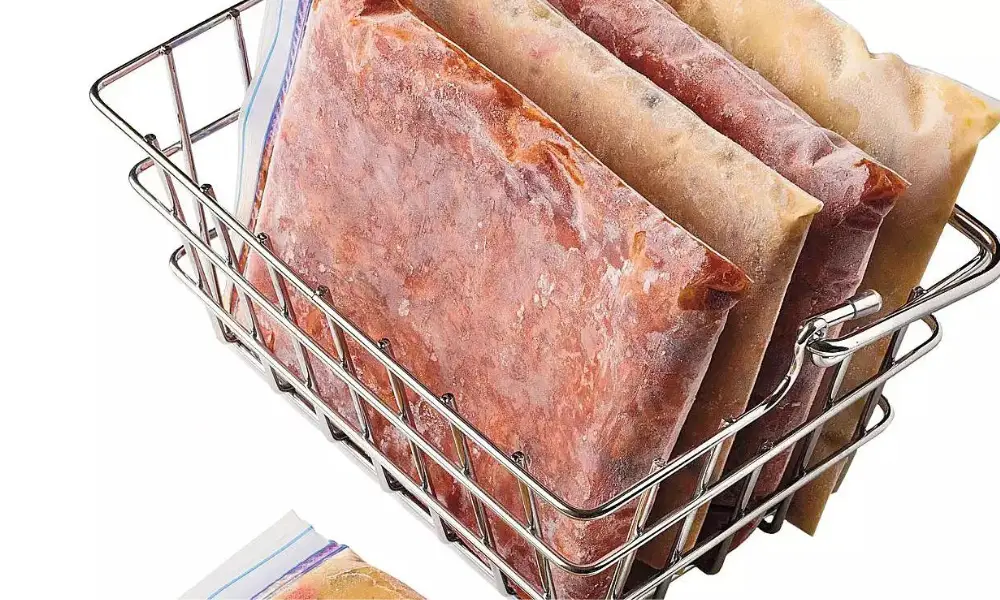Did you know that soup can be made in advance and frozen for a simple dinner later? Soup must first cool in an ice cube tray before freezing for the best results. After pouring it into a zip-top plastic freezer bag, you put it flat in the freezer. Pretty simple, yes? Here’s all you need to know about securely preserving soup in the freezer, including a few additional factors to consider when freezing soup.

Can Soup be Freeze?
You certainly can! There are veggies to chop, seasonings to buy, and other ingredients to choose from on the counter while making a fresh batch of soup. It takes a lot of work to get the rich pleasure of homemade soup! Going to all that bother to produce a few short serves hardly seems worth it, which is why freezing soup is such a common cooking fad. A fantastic technique to keep those flavorful leftovers without compromising the flavor and consistency is to freeze soup.
How to Freeze Soup in Bag?
With about an inch of space, ladle soup into an airtight bag, such as a Glad Freezer Quart Bag. Before carefully closing and placing bags in the lowest area of your freezer, squeeze out any extra air. To save space, stack the frozen contents of the bags on top of one another.
The plan is to freeze them flat. Fill some sturdy zip-top freezer bags with the contents. Place the bags on a baking sheet or the floor of your freezer, press out as much air as possible, and then freeze.
Once frozen, liquid meals like soup, beans, and broth (or any other flat, stiff rectangles) can be piled like t-shirts or kept upright like books on a shelf.
The benefit is that flat items take up significantly less space in a freezer than a collection of oddly shaped containers, and it’s typically simpler to locate the specific soup or beans you need for dinner without rummaging around the freezer’s hidden corners.
Foods that are frozen flat thaw significantly more quickly than those frozen in solid bricks because they are relatively thin and have a large surface area.
What are the Tips for Using Freezing Bag?
I am aware that this approach calls for some faith, particularly when worrying about bursts or leaking bags. Here are some pointers to assist with that:
Make sure the label on the box genuinely reads “freezer,” and use high-quality freezer bags. Unlike sandwich bags, these bags are more substantial and contain thicker plastic. I also believe investing in high-quality bags from a reputable brand is worthwhile. I typically use Ziploc freezer bags in the quart size.
Avoid stuffing the bags too full; liquids expand as they freeze, allowing space between items. I typically only put two to three cups of food in a quart-sized bag and placed roughly three quarts (12 cups) in bags the size of gallons.
Never stack bags higher than three or four high. Although I haven’t tried this, I become nervous when there are more than four stacked bags since I think the weight of the ones on top might cause the ones at the bottom to pop.
What is the Need for Freezing Soup?
You might be wondering why frozen food is so popular. You may find it more convenient for you during hectic weeks! Is there anything better than opening the freezer to discover a tasty soup or crockpot meal without any preparation?.
When a loved one is going through a phase in their life where they don’t have the time to cook meals in general, frozen (healthy) dinners can be a lifesaver.
For a pregnant woman or a family going through a difficult period, freezer meals or premade soups are excellent options for meal preparation.
For a variety of reasons, we enjoy freezing soup.
It’s simple to mix nutritious and delicious items into soup! When you prepare a healthy recipe in advance and store it in the freezer, you can always count on having a nutritious meal option available.
Making soup for friends and family makes meals easier for the recipient (particularly for expectant mothers)!
There are countless soup recipe alternatives! You can make a tonne of different soup recipes and freeze them while still having a wide range of flavor options!
How can Soup be Freeze-Dried in Small Portions?
Understanding how to portion out soup will significantly improve the taste of your reheated meals. The best approach to freezing soup in individual servings is to divide your recipe into small freezer containers, each holding one serving, allowing about an inch of space between the casserole and the lid. There are several distinct justifications for storing soup in separate servings.
For starters, the soup will cool, freeze, and reheat more effectively the lower the quantity. Because the amount can refrigerate and freeze more evenly, you’ll find that smaller portions preserve taste and consistency far better than bulk batches. Since the center takes longer to freeze when storing many servings in an identical container, ice crystals can form and alter the flavor and texture.
Some soups have ingredients that can expand in sweltering conditions. When storing hash in large quantities, it might be challenging to predict how much growth to account for, whereas tiny servings only require an inch more container space. Remember to always allow for expansion when storing soup in individual servings.
Which Containers are Best for Freezing Soup?
The most crucial thing is to ensure you are using a container meant for freezer storage while putting soup in the freezer, whether in bags or jars. Anything else won’t be able to withstand the cold without breaking.
Regular bags and containers and freezer bags and containers are very different. Don’t let the barrier’s gaps cause you to lose one of your favorite containers or to discover soup that has been frozen. The disposable plastic containers for freezing are just next to those for mild temperatures and make the perfect containers for soup.
Select freezer-safe reusable plastic containers like Tupperware from the selection (for example, Tupperware uses a snowflake icon on freezer-friendly containers). Mason jars and other glass containers can be freezer-friendly if you provide enough room for expansion.
How to Freeze Soup in Mason Jars, Glass Containers, Tupperware, and Plastic Containers?
Always let it cool before freezing, no matter what container you use to store your soup, whether made of glass or plastic.
Because it will take time for the soup to cool and freeze, it is easy for food-borne bacteria to grow in a tub of hot soup. The temperature of the other foods in your freezer may also be compromised.
It’s critical to provide space in any plastic or glass container you use to freeze soup so the food can expand without breaking the container. Allow the food to grow in the container by leaving at least a 34-inch space at the top. On the other hand, you don’t want to go to too much room because the soup will freeze and burn more quickly the more air there is inside the storage container.
The ideal distance between the surface of the soup and the lid is less than an inch.
Always portion soup into tiny or individual servings before freezing it to speed up chilling and reduce the danger of foodborne diseases.
Is Freezing Soup in Plastic Containers Safe?
Using the proper containers, you can safely freeze soup in plastic, and plastics are not created equally. Always keep food in plastic containers that are safe to handle and are free of polyvinyl chloride, polycarbonate, and polystyrene.
These substances may degrade while frozen, harming the container and, worse, allowing pollutants to contaminate the food. The plastic containers that are BPA-free are another excellent choice for the motto “better safe than sorry.”
Some Soups that Freeze Well
Not all soups can be frozen, just like the plastic containers we store them in. Generally speaking, soups with a broth base freeze nicely, rice, beans, and meat soups freeze well, while starchy vegetables, noodles, and cream soups can be trickier. We’ve provided a few tips below to assist you in successfully freezing various soup variations.
How to Heat Frozen Soup?
Once the frozen soup has thawed, several ways to reheat it. Choose the technique that works best for you by using this quick guide to reheating the frozen soup.
Empty the contents of the frozen container into a microwave-safe bowl once it has partially or fully thawed, and then cover it with plastic wrap. Make ventilation holes in the wrap, microwave for 30 to 60 seconds, stirring once or twice to keep the consistency consistent. If necessary, repeat.
Stove: Fill a pot with the frozen soup. When heating partially thawed soup, cover the bottom of the pot with water to avoid the pot burning. Cook until well cooked over medium-high heat. Frequently stir.
Crockpot: Whether frozen soups have been thawed or not, we do not advise reheating them in a crock pot or slow cooker. These devices will hold cold food at dangerous temperatures for an excessive amount of time. For a quick and simple supper, use a stovetop or microwave instead.
Unlike a crock pot, an instant pot is a fantastic appliance for reheating the frozen soup. Cook the frozen soup for 5 minutes using the pressure cooker, and done now! Reheating cream-based soups in an instant pot should be avoided.
How Long does Soup Stay Fresh in the Refrigerator Before it Freezes?
Perhaps you believed you could finish the entire batch of soup before it went bad. Perhaps you were too busy to remember to put it in the freezer. In either case, it’s critical to consider your ingredients before allowing the soup to chill in the fridge for an extended period.
Any meat will most likely spoil in three to four days. Therefore, you must freeze that batch of soup within three days of making it, whether it contains chicken, beef, pork, or any other type of meat. You might get away with an extra day or two if it’s a vegetable soup, but why take the chance?
The day after you cook your soup, we advise freezing it. Anything that isn’t ready to eat right away must be put in the freezer as soon as possible and stored in the appropriate containers. Food poisoning is completely avoided if the soup is always put in the freezer the day it is cooked.
According to the Federal Food Safety Information, it can be frozen three to four days after preparation.
How Long can Soup be Frozen?
Let’s now discuss how long your soup will remain edible after being frozen. The Federal Food Safety Information states that frozen soup can be stored for two to three months. This period serves as the general guideline for frozen soup, assuming that the soup was correctly made, kept, and defrosted before reheating.
Does this imply that you need to freeze it for three months? We advise against doing that, if at all possible. The soup will taste less fresh when reheated the longer it has been frozen. Despite the freezer containers’ protection, any kind of food kept in the freezer for an extended period is vulnerable to microscopic ice crystals that develop in the food’s fibers and affect the taste and texture.
Because of this, there is a proper approach to freezing some soup varieties.
Conclusion
Freezing soup in bags is not as difficult as you might think. It’s just a matter of choosing the right containers: Mason jars, Freezer-specific plastic bags, or single-serve baggies. These containers can store a large batch of soup in minutes. To make storing soup in bags easy, consider buying Souper Cubes(r) trays and plastic freezer-specific bags.
